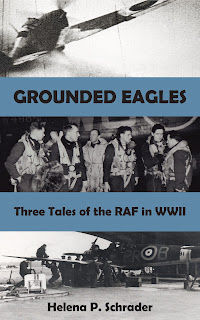617's Most Influential CO: Leonard Cheshire
No one is more closely associated with 617 Squadron then Wing Commander Guy Gibson. He formed the squadron, hand-picking many of the pilots. He led it to fame on the Dams Raid. Yet he literally only flew on one operation with the squadron, and his command ended after less than three months. No other wartime CO was on the squadron for a shorter period.
The CO who commanded the squadron longest -- albeit, even then, only eight months -- was also the man who gave it a mission. Thus even if his name is not so immediately associated with 617, he was in fact more influential than any of the five men who led the squadron in WWII.
Cheshire, who by September 1943 already had a distinguished war record and was the youngest Group Captain in the RAF recruited to command 617 Squadron in order to help solve a pressing problem. With their backs increasingly to the wall, the Germans had unleashed their creativity to develop four devilishly advanced and potentially game-changing weapons. Two of these were early forms of missiles, or “flying bombs,” the familiar V1s and V2. The third were huge, long-range guns being installed in the Pas-de-Calais, and the fourth was the mostly battery-powered XXI-type submarines with underwater speeds faster than most merchantmen. All of these super-weapons were being constructed and installed in “hardened” sites protected by reinforced concrete meters thick. The RAF had to find a means to penetrate those concrete walls and destroy the weapons underneath.
The engineering genius Barnes-Wallis, famous for developing the bouncing bombs that had destroyed the Ruhr Dams, had already come up with a new bomb. This so-called “Earthquake” bomb if dropped from 18,000 feet or more could reach supersonic speeds and penetrate meters thick concrete. The problem was that the bomb was only effective if delivered very precisely — within 12 meters of the target. Cheshire’s challenge, therefore, was to deliver bombs within that margin of error, but soon realized this was irrelevant if the target could not be found and identified in the first place. The target marking techniques then in use at the time, however, were woefully inaccurate.
Cheshire convinced AVM Harris to allow him to develop his own marking techniques. Eventually, after intensive experimentation on the bombing range, Cheshire and the pilots working with him developed a technique that entailed first dropping illuminating flares, which then allowed a low-flying aircraft to deliver a marking flare by dive-bombing to 100 feet, after which the remaining aircraft could drop their bombs accurately (using new bombsites and the aerodynamic Tall Boy) from 18,000 feet or more. Cheshire proved the concept with — of all aircraft! — a Lancaster.
Cheshire and 617 Squadron first demonstrated the effectiveness of the technique in a raid on the aero-engine factory in Limoges, France. Cheshire first flew over the factory at 20 feet to warn the French workers. They got the hint and ran out. Then Cheshire dropped the marker flare on the roof of the factory and called in the remaining aircraft of 617 one at a time. The factory was obliterated without a single French casualty. Accuracy like that was not standard practice in the USAAF any more than in the RAF!
The next day, Cheshire was removed from command of 617 Squadron by Cochrane. He had completed a total of 100 operational sorties since the start of the war and he had transformed 617 from a "one operation" squadron into the RAF's leading "special operations" outfit. Furthermore, the target marking methods he had evolved were been recognized as effective and were increasingly used by other squadrons as well when circumstances permitted.
My novels about the RAF in WWII are intended as tributes to the men in the air and on the ground that made a victory in Europe against fascism possible.
Riding the icy, moonlit sky,
they took the war to Hitler.
Their chances of survival were less than fifty percent.
Their average age was 21.
This is the story of just one bomber pilot, his crew and the woman he loved.
It is intended as a tribute to them all.
or Barnes and Noble.

"Where Eagles Never Flew" was the the winner of a Hemingway Award for 20th Century Wartime Fiction and a Maincrest Media Award for Military Fiction. Find out more at: https://crossseaspress.com/where-eagles-never-flew
For more information about all my aviation books visit: https://www.helenapschrader.com/aviation.html







Comments
Post a Comment